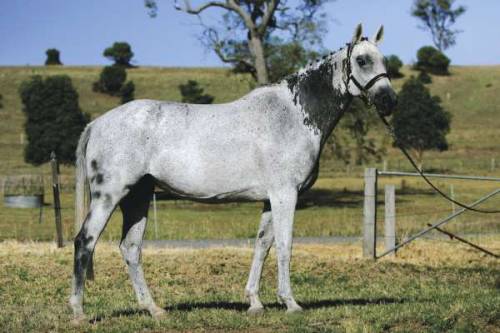Grey Horse Colours
So this post will show the differences in how some horses grey out, and what we call them. The end result is usually a completely 'white' or flea-bitten grey, but depending on the horses base colour, their other genes at play, and the stage of greying out, there are many different shades of grey.
While many grey horses will appear to be white, their black skin confirms that they are greys and not a cremello or perlino or other similar colours like dominant white. Pink skin can be seen on them, but only under where they have their white markings. These aren't always easy to see on an older grey horse, but they are still there! The horse below obviously has a snip, but it could easily be a much longer strip down the horses face. One may have to move some hair out of the way to see how far the pink skin continues, or look at photos of the horse as a foal, but the markings are always there.
Steel/Iron Grey
All dark base coloured horses will be a steel grey early in their greying-out process
 |
| https://www.pinterest.ca/pin/810436895416128801/ |
Flea-bitten Grey
Some greys may retain small flecks of colour
Dapple Grey
Dappling is a result of the Silver Dapple gene
Mulberry Grey
Retaining red pigments in mane and tail
Rose Grey
Retaining more of the red pigments in the coat
 |
| https://hdwallpapers.cat/wallpaper/the-rose-grey-equus-horse-stallion-animals-6u6P.jpg |
While many grey horses will appear to be white, their black skin confirms that they are greys and not a cremello or perlino or other similar colours like dominant white. Pink skin can be seen on them, but only under where they have their white markings. These aren't always easy to see on an older grey horse, but they are still there! The horse below obviously has a snip, but it could easily be a much longer strip down the horses face. One may have to move some hair out of the way to see how far the pink skin continues, or look at photos of the horse as a foal, but the markings are always there.
 |
| https://pixabay.com/photos/horse-tongue-poking-out-sticking-937683/ |
Some rare markings only seen in grey horses include blood markings (quite commonly along the shoulder if it is to occur). This is when an area of the body retains some pigments well into the elderly phases of a grey horses life, more common to flea-bitten greys than others. This marking can be small, or rather extensive. More commonly it is a chestnut, reddish colour (hence the name) but can be black too. Can be anywhere on the body.
 |
| https://en.wikipedia.org/wiki/Gray_horse |
Black bloody markings on the neck and right hock/flank. Likely more on the other side as well, but not symmetrical.
 |
| https://colourfulequines.tumblr.com/post/30372370347/grey-warmblood-mare-with-black-bloody-shoulder |
Chubari spots are spots of white that appear on a grey coat and they will slowly expand and turn the horse a very pale grey. Not all horses grey out in this pattern, but it is an interesting, temporary, marking to note.
 |
| https://horsenetwork.com/2017/06/beyond-blazes/ |







Comments
Post a Comment